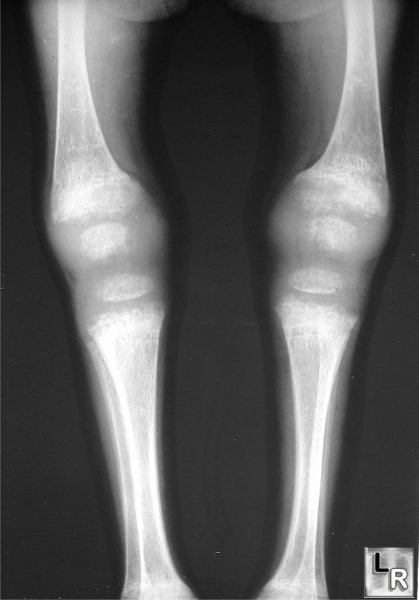Assalammualaikum W.B.T & Salam Sejahtera you all~
once again, aku pun pelik ma diri aku skunk, i dunno why aq suka post benda benda berkaitan ma medic ni..ok im not a skema girl k..aku just mo share ma kmu pasal penyakit ni..
actually first tym aku dengar pasal penyakit tym aku tgh tengok BERSAMAMU kat tibi 3 hari tu..i think last 2 week kali ar..lupa uda la bila..yg pntg dr sna la aku tau pasal penyakit ni..
aku kesian tgok budak dalam tibi tu, umur dha 11 tahun(klo xsilap) tp susuk tubuh dia sma mcm budak budak umur 3 o 4 tahun gitu..poor him..abg dia pun meninggal sbb sakit yg sma..mula2 tym aku tengok tu, dorang ckp xde cures dia, skali aku baca kat web, ada bha..(malaysia x explore ag ka?)..hurm..xmo ckp bnyk..kmu bca ja la pa actually penyakit ni...
What is renal osteodystrophy?
The medical term "renal" describes things related to the kidneys. Renal osteodystrophy is a bone disease that occurs when your kidneys fail to maintain the proper levels of calcium and phosphorus in your blood. It's a common problem in people with kidney disease and affects 90 percent of dialysis patients.
Renal osteodystrophy is most serious in children because their bones are still growing. The condition slows bone growth and causes deformities. One such deformity occurs when the legs bend inward toward each other or outward away from each other; this deformity is referred to as "renal rickets." Another important consequence is short stature. Symptoms can be seen in growing children with renal disease even before they start dialysis.
The bone changes from renal osteodystrophy can begin many years before symptoms appear in adults with kidney disease. For this reason, it's called the "silent crippler." The symptoms of renal osteodystrophy aren't usually seen in adults until they have been on dialysis for several years. Older patients and women who have gone through menopause are at greater risk for this disease because they're already vulnerable to osteoporosis, another bone disease, even without kidney disease. If left untreated, the bones gradually become thin and weak, and a person with renal osteodystrophy may begin to feel bone and joint pain. There's also an increased risk of bone fractures.
How is renal osteodystrophy diagnosed?
To diagnose renal osteodystrophy, your doctor may take a sample of your blood to measure levels of calcium, phosphorus, PTH, and calcitriol. The doctor may perform a bone biopsy to see how dense your bones are. A bone biopsy is done under local anesthesia and involves removing a small sample of bone from the hip and analyzing it under a microscope. Determining the cause of renal osteodystrophy helps the doctor decide on a course of treatment.
How is osteodystrophy treated?
Controlling PTH levels prevents calcium from being withdrawn from the bones. Usually, overactive parathyroid glands are controllable with a change in diet, dialysis treatment, or medication. The drug cinacalcet hydrochloride (Sensipar), approved by the Food and Drug Administration in 2004, lowers PTH levels by imitating calcium. If PTH levels can't be controlled, the parathyroid glands may need to be removed surgically.
If your kidneys aren't making adequate amounts of calcitriol, you can take synthetic calcitriol as a pill or in an injectable form. Your doctor may prescribe a calcium supplement in addition to calcitriol.
Renal osteodystrophy can also be treated with changes in diet. Reducing dietary intake of phosphorus is one of the most important steps in preventing bone disease. Almost all foods contain phosphorus, but it's especially high in milk, cheese, dried beans, peas, nuts, and peanut butter. Limit drinks such as cocoa, dark sodas, and beer. Often, medications such as calcium carbonate (Tums),calcium acetate (PhosLo), sevelamer hydrochloride (Renagel), or lanthanum carbonate (Fosrenol) are prescribed with meals and snacks to bind phosphorus in the bowel. These decrease the absorption of phosphorus into the blood. Be sure your phosphate binder is aluminum-free because aluminum can be toxic and cause anemia. A renal dietitian can help develop a dietary plan to control phosphorus levels in the blood.
Exercise has been found to increase bone strength in some patients. It's important, however, to consult a doctor or health care professional before beginning any exercise program.
A good treatment program, including proper attention to dialysis, diet, and medications, can improve your body's ability to repair bones damaged by renal osteodystrophy.
klo mo tau lebih bnyk ag klik sini ja k..soe, explanation dia dlm english~..tq Mr.Farmasi tolong aku carikan info ni!
wassalam~



2 comments:
syan~ next time ko kasi summary bah~ hahahah. malas aku mo baca :P
nice entry. i like~ :D
haha..okai wawan..len kali aq bg maksud dia ja la..then bg link..haha..okai?
Post a Comment